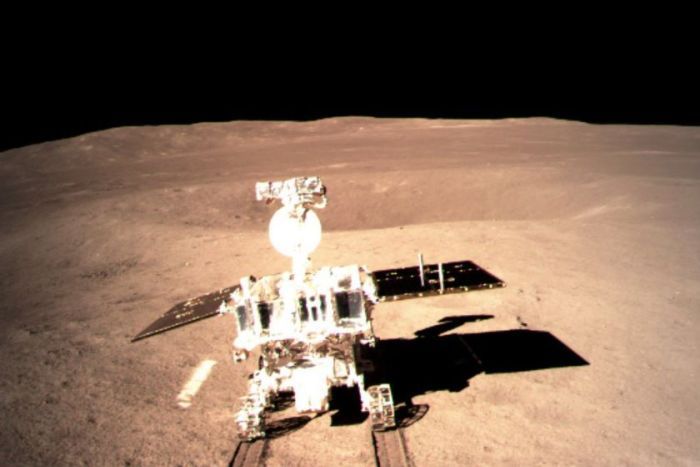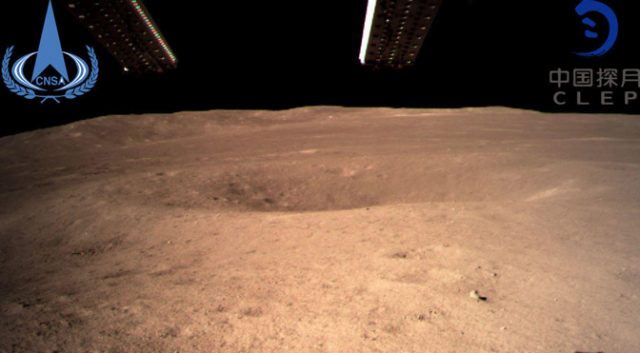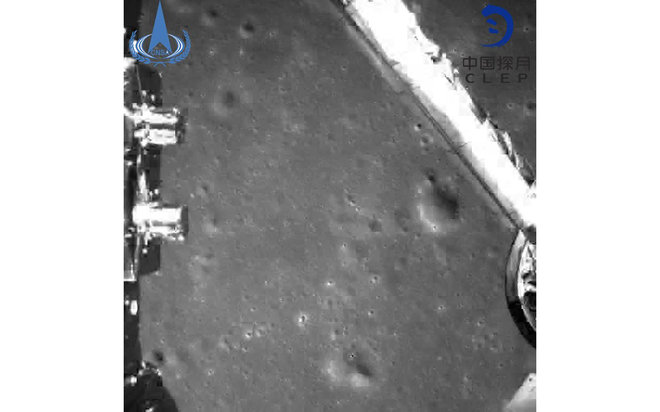The Chang'e-4 Made Its Historic Landing And Sent The First Photo From The Dark Side Of The Moon
Dhir Acharya - Jan 04, 2019

On January 2, 2019, China's Chang'e-4 successfully landed on the other side of the Moon, it has sent back the first photo taken on the planet surface.
- China's Chang'e-4 Discovered 3 Layers Under The Surface Of The Moon's Dark Side
- How A Farmer’s Son Contributed To The Successful Launch Of Chandrayaan-II
- Chang'e-4 Spotted In A Lunar Crater By NASA Moon Orbiter
For the first time in the history of space flight and the entire humanity, we have a spaceship landing on the other side of the moon.
At 10:26 AM, January 3, 2019, in Beijing (6:26 PM PT, January 2, 2019), the Chang’e-4 achieved this milestone. The Chinese space agency managed to land its spacecraft in Von Karman crater which is located on the far side of the moon. The official announcement went public at 12 PM Beijing (8 PM PT) via China Central Television (CCTV).
A few hours after landing, the Chang’e-4 sent back to us the first photo it took of the moon’s surface via the relay satellite Magpie Bridge (Queqiao).

The first photo sent back from the other side of the Moon
The Chang’e-4 consists of a lander and a six-wheel rover. On December 12, the spaceship entered the moon’s orbit and then landed in an elliptical orbit around the moon, which helped decrease the distance between the craft and the planet to only 15 kilometers.
Unlike the historic NASA’s Mars mission in November and its flyby of the Kuiper Belt Object 2014 MU69 on New Year’s Day, the landing of Chang’e-4 was not broadcast. The news was announced on the social network Weibo instead. China’s media agencies also posted the news on Twitter, but the posts were removed shortly after.
The Chang’e-4 faces challenges on its own
According to journalist Andrew Jones, who reports on China’s space program, the landing of Chang’e-4 needed laser ranging as well as optical cameras to navigate and avoid coarse hazard and velocity. This meant the Chang’e-4 had to do everything on its own using its critical scientific payload.

Chang'e-4 also sent a photo of the landing process
Also known as the dark side of the moon, this half still receives sunlight but never faces our Earth due to tidal locking. As a result, maintaining radio contact for communication from here is such a challenge, especially if we’re to bring humans.
To contact with the rover, in May, Queqiao – the relay satellite – was launched into a halo orbit over the moon’s far side. Queqiao will help the Chang’e-4 call home and send scientific to the Earth via the relay.
The Chang'e-4's missions
The lander and rover each have three cameras attached and other instruments that will help China study the geology of Von Karman.
![]()
Scientists believe that in the South Pole-Aitken (SPA) Basin, the 13-kilometer-deep ancient crater, there are materials from deep down the moon’s soil that will help us understand what the planet is made of. Also, the lander brings silkworm eggs and seeds with the mission to find out if these two forms and develop on the planet.
Furthermore, the Chang’e-4 carries other instruments that have been developed by German and Swedish engineers, allowing it to research the solar wind and charged particles burst from the atmosphere of the Sun. Saudi Arabia and Netherlands partners also provided payloads on this lander.
Featured Stories

Features - Jul 01, 2025
What Are The Fastest Passenger Vehicles Ever Created?

Features - Jun 25, 2025
Japan Hydrogen Breakthrough: Scientists Crack the Clean Energy Code with...

ICT News - Jun 25, 2025
AI Intimidation Tactics: CEOs Turn Flawed Technology Into Employee Fear Machine

Review - Jun 25, 2025
Windows 11 Problems: Is Microsoft's "Best" OS Actually Getting Worse?

Features - Jun 22, 2025
Telegram Founder Pavel Durov Plans to Split $14 Billion Fortune Among 106 Children

ICT News - Jun 22, 2025
Neuralink Telepathy Chip Enables Quadriplegic Rob Greiner to Control Games with...

Features - Jun 21, 2025
This Over $100 Bottle Has Nothing But Fresh Air Inside

Features - Jun 18, 2025
Best Mobile VPN Apps for Gaming 2025: Complete Guide

Features - Jun 18, 2025
A Math Formula Tells Us How Long Everything Will Live

Features - Jun 16, 2025
Comments
Sort by Newest | Popular